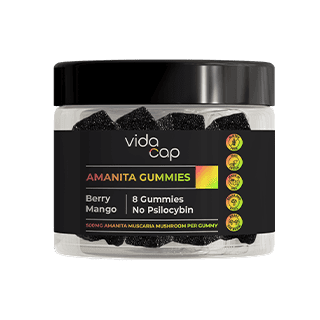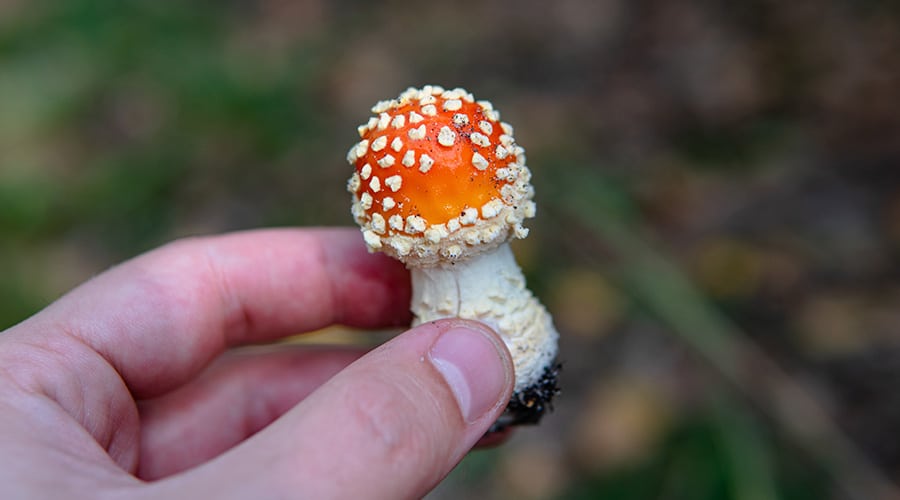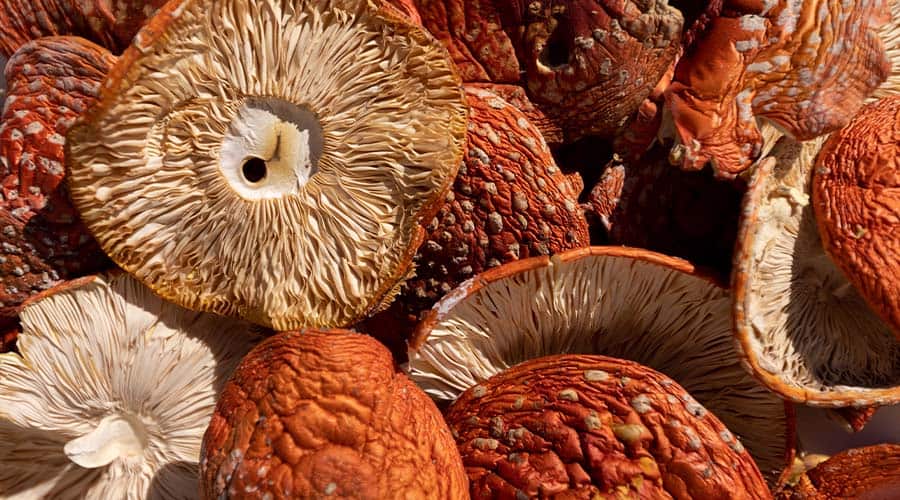Since amanita doesn’t contain psilocybin, the famed psychedelic substance found in ‘magic mushrooms,’ it is currently legal in every American state barring Louisiana. Furthermore, residents of dozens of countries worldwide can legally enjoy this fascinating mushroom.
When you buy amanita, it is typically already dried and ready to use. However, if you have foraged fresh mushrooms, you must complete the process yourself to get the best out of them. Drying amanita removes moisture, thus preventing decay and the growth of harmful microorganisms.
This guide highlights some different methods of drying Amanita muscaria and provides storage information.

If you’re an amanita aficionado who would love to harvest and dry fresh mushrooms but don’t have the time, VidaCap’s gummies are the perfect solution. The brand painstakingly dries and decarboxylates every amanita mushroom it harvests to ensure a premium muscimol content. You can have delicious amanita gummies delivered to your doorstep with just a few clicks.
Why Pre-Dry My Mushrooms in the First Place?
Correctly drying amanita mushrooms involves “pre-drying” them first. This process involves initial moisture removal before proceeding with your last drying method. By pre-drying your amanita, you reduce its initial moisture content. This is crucial as you decrease the risk of mold growth, spoilage, and decay.

It’s important to note that Amanita muscaria mushrooms have a high initial moisture content. So, if you proceed with your final drying method before pre-drying the mushrooms, consequences may include loss of potency, uneven drying, and spoilage.
Getting rid of some moisture immediately helps the main drying process become more efficient. Also, proper drying preserves the mushroom’s muscimol and ibotenic acid content; these are the main active compounds in amanita.
How to Pre-Dry Your Amanita Muscaria Mushrooms
As pre-drying is relatively easy, there’s no reason to skip this essential step. Once you harvest your amanita, spread them out on a dry towel or piece of cardboard. It is important to ensure they’re not touching each other.
Move the towel or cardboard to a well-ventilated area that’s away from direct sunlight. Some people like to use a cupboard or a section of a walk-in closet. Another option is to put the mushrooms in front of a fan, which works to gently reduce moisture.
Ultimately, pre-drying shouldn’t take more than a few hours. Take note of how your amanita’s appearance changes. If they seem a little wrinkly and have a slightly rubbery feel, it’s time to proceed to your principal drying method.
Does Cutting/Tearing Mushrooms Reduce Potency?
A school of thought suggests cutting or tearing the mushrooms will decrease their potency. This is a false assertion, as long as you carefully handle the amanita and dry them properly afterward.
You may want to tear or cut large mushrooms to ensure they’re easier to dry. This process could lead to a small loss of its active compounds to oxidation. However, it should have only a minimal impact if you subsequently dry the mushrooms efficiently.
Correct drying is a much bigger factor in preserving your mushrooms’ potency. Do it correctly, and you stop mold and harmful bacteria from forming, reduce the chances of the mushrooms degrading and allow them to be stored for a long time.
Preparing Your Amanita Mushrooms
Before drying your mushrooms, it is necessary to clean them. Use a clean cloth or soft-bristled brush to remove visible dirt or debris from your mushrooms. Don’t use water because amanita already has a high-water content. Adding excess moisture only increases the risk of mold growth.
Next, check each mushroom individually and remove any additional debris you find. Check under the caps in crevices. If you find removing certain pieces of dirt tough, gently remove them with tweezers or a small knife.
Finally, examine the mushrooms, checking for signs of decay, pest infestation, or damage. Use a sharp, clean knife to remove any soft or discolored areas. This is a crucial step as it ensures that only the amanita mushroom’s intact and healthy parts are kept for the drying process.
The Simplest Drying Methods for Amanita Muscaria
There’s more than one way to dry your amanita mushrooms. They range from simple air drying to utilizing a food dehydrator. You can even dry your mushrooms in the oven at a pinch (although it is perhaps the least desirable method).
Here are some of the best-known ways to dry Amanita muscaria mushrooms.
Air Drying
This is the simplest method and is little more than an extension of pre-drying. The main downside is that air drying takes slightly longer than other options. However, moisture will eventually leave over time, although you should only air dry in a room with a relative humidity (RH) level of 55% or less. Here’s how to do it.
You will need
- A mesh screen or drying rack (although you can resort to cardboard)
- A well-ventilated area
- A fan
- Patience
Ideally, you will have a drying rack or a mesh screen. However, if you have neither, dry cardboard will do. Place the pre-dried and cleaned amanita in a single layer on the drying surface of your choice. Doing so ensures proper airflow for the mushrooms, which helps the drying process.
Place the rack in a properly ventilated location. Steer clear of any room exposed to direct sunlight or with a high RH level.
Situate the fan where it’s constantly blowing air on the mushrooms. The fan isn’t essential if the room is extremely dry. You must check on the amanita daily. You’ll notice that they become more rigid within a few hours. The mushrooms are ‘done’ when they become so dry that they snap when bent.
Using a Dehydrator
Ideally, you will have a dehydrator, which is probably the best way to dry your Amanita muscaria mushrooms. Dehydrators remove water via airflow and a heat source. As a result, you can store your dried mushrooms for a very long time.
There’s no need to spend hours shopping for the ‘perfect’ hydrator. Any food dehydrator will work.
Place your mushrooms on the dehydrator’s trays in a single layer. As with the air-drying method, ensure enough space between each one. Set the device to a temperature between 100- and 140-degrees Fahrenheit.
Depending on how long you pre-dried your amanita, a dehydrator should finish the job in 4 to 8 hours.
Oven Drying
This isn’t the best option, but you can try it if you want to dry the amanita mushrooms quickly and don’t have a dehydrator. Place the mushrooms in a single layer on a baking sheet. Set the oven’s temperature to around 120 to 140 degrees, and watch your mushrooms closely.
It can take 3 to 8 hours for your mushrooms to be dry enough to snap. However, check them regularly. Otherwise, you could accidentally ‘cook’ them, destroying their potency.
Using a Desiccant
A desiccant is a chemical substance that absorbs water from the air, reducing its RH. You can use it to ensure your mushrooms are extra dry. However, it is best to air dry or use the dehydrator or oven first. A desiccant works best when extracting the last few percent of moisture from your amanita.
Silica gel is the most popular desiccant and is usually what you’ll find in packaging. Other options include calcium salts and anhydrous calcium sulphate. Some people make their own using Epsom salts.
The desiccant will get to work and remove moisture from the amanita. The process may take a few days, but eventually, your mushrooms will be extra dry.
How to Store Your Dried Amanita Muscaria Mushrooms
Once you successfully dry your harvest, storing them properly is a critical step. Correct storage helps retain your mushrooms’ potency and prevents them from spoiling.

Let your amanita cool completely once the drying process is finished. Doing so stops condensation from building inside the storage container. Place your mushrooms in an airtight container like a glass mason jar. If you have a large harvest, use several containers, labeling each one with the drying date.
Store the containers in a cool, dry place away from sunlight. The ideal storage temperature is between 50- and 60-degrees Fahrenheit. Regularly check your mushrooms for signs of insect infestation, mold, or moisture. Also, if there are children in your house, please ensure the mushrooms remain far from their reach.

If you’re an amanita aficionado who would love to harvest and dry fresh mushrooms but don’t have the time, VidaCap’s gummies are the perfect solution. The brand painstakingly dries and decarboxylates every amanita mushroom it harvests to ensure a premium muscimol content. You can have delicious amanita gummies delivered to your doorstep with just a few clicks.
Final Thoughts on Storing Amanita Muscaria Mushrooms
Hopefully, this guide was useful in your quest to dry your amanita mushrooms correctly. Drying your mushrooms is important to retain their potency, extend their shelf life, and get the best out of what amanita offers.
Drying these mushrooms requires patience and attention to detail. However, the effort is well worth it when you enjoy their benefits several months after foraging for them.






